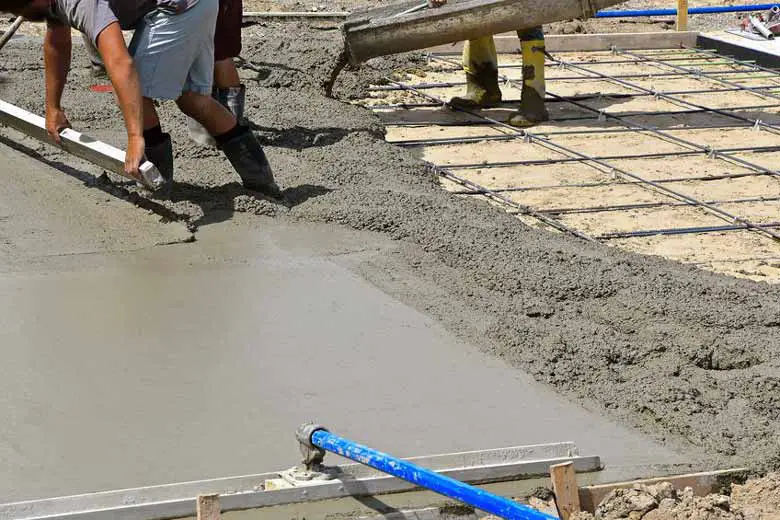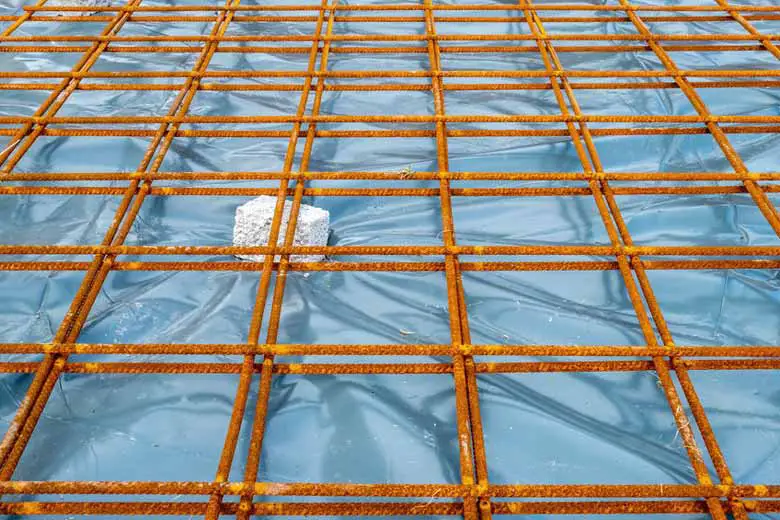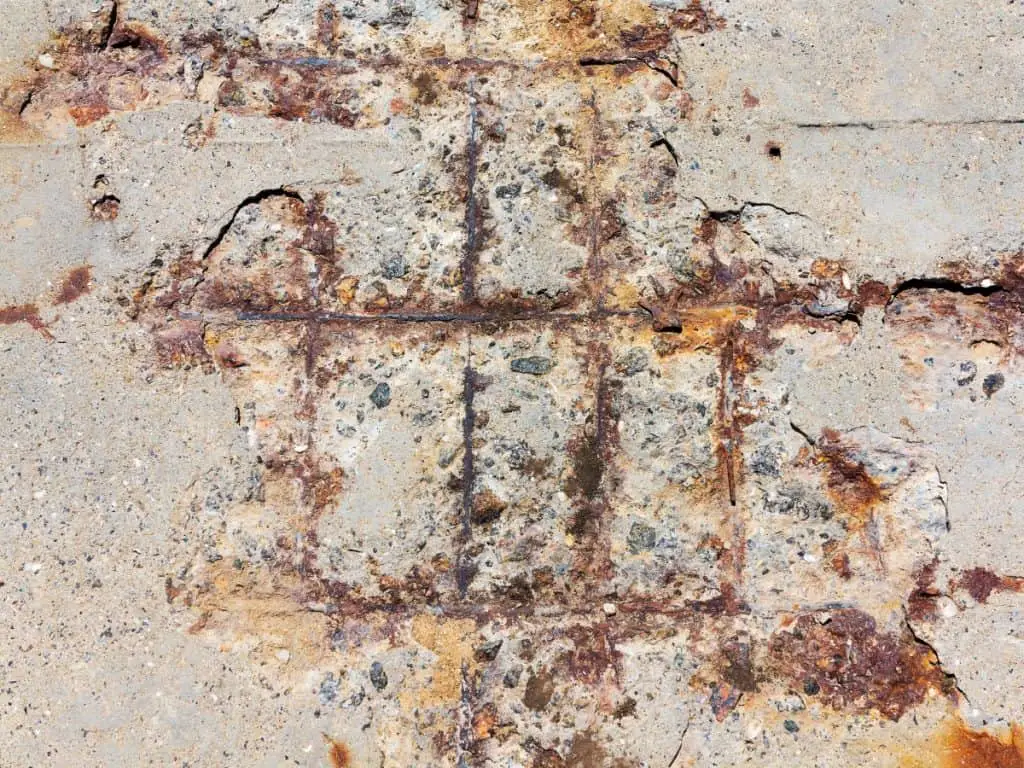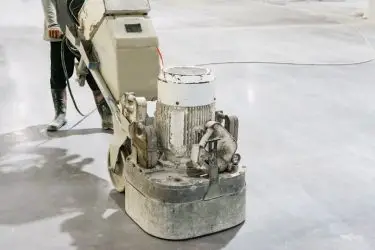If you’re planning to pour a concrete slab, adding rebar to the mix can significantly increase the cost of the project. It’s only natural to look for ways to avoid this cost, but should you do it? Can you pour the slab without using rebar at all?
You can pour a concrete slab without rebar if the slab is less than 5” (12.7 cm) thick and won’t support heavy structures. Thicker slabs or those designed to frequently shoulder the weight of large vehicles need rebar. Slabs exposed to regular freeze-thaw cycles will also benefit from added rebar.
The rest of the article will cover all you need to know about pouring a concrete slab without rebar. I’ll cover some scenarios where your slab will benefit from rebar infusion.

Table of Contents
Concrete Slabs and Rebar: What You Need To Know
Rebar (concrete reinforcing bars) help ensure greater tensile strength for any concrete slab. Infusing rebar in a slab reduces the risk of cracks.
The size and thickness of the slab are some of the chief factors for determining if you should add rebar or not. The weights of concrete slabs that are five inches (12.7 cm) or thicker mean they are likely to disintegrate faster without rebar.
Similarly, the use of the concrete slab is a key factor when choosing to remove rebar from the construction costs. If the concrete slab will hold heavy equipment, machinery, or supplies, it’s not a good idea to pour without rebar. Such slabs might break, crack or separate at the expansion joints in worst-case scenarios.
On the other hand, concrete slabs on driveways for small cars or construction that will mostly see little human or vehicular traffic do not need rebar. Slabs poured on properly prepared ground featuring a compacted base also don’t need rebar.
Keep in mind that adding rebar doesn’t completely make the slab immune to cracks. However, it reduces the overall impact of the cracks, keeping the slab from disintegration.
More Scenarios Where Rebar Is Important When Pouring Concrete Slabs
Using rebar in your concrete slabs may look like an unnecessary expense. However, there are many scenarios where a web of rebar is important for the integrity of a structure. A qualified structural engineer will provide you with all the details you need on this front, but here is a quick rundown you can work with:
Construction of Thick Concrete Slabs on Disturbed Ground
As discussed above, all slabs thicker than five inches (12.7 cm) need an intricate web of rebar to maintain integrity. However, the need for rebar doubles when the construction is on disturbed or weak ground. Constructions over drainage pipes or ditches also need rebar to function effectively.
If the concrete slab supports heavy machinery, vehicles, or barrels of liquid after construction, it’s likely to disintegrate soon after construction due to the pressures from above and beneath it.

Slabs for Concrete Patio Near Buildings
Concrete patios near buildings are often built around backfilled ground. They need rebar to ensure increased tensile strength. This is especially true if you plan to add a spa, hot tub, or pizza oven to the patio. If you intend to use the patio as an outdoor kitchen or fireplace or to mount a pergola or other similar structure, you need to add rebar before pouring the concrete.
Concrete Slabs on Walkways
Walkway slabs often feature expansion cracks which are often weak points. If the slab is surrounded by tree roots, weak ground, or drainage areas, adding rebar can help minimize the speed of cracks. If the walkways cross driveways or see regular heavy-equipment traffic, they also need to contain rebar.
Thinner Concrete Slabs Providing Support
I mentioned above that concrete slabs less than 5” (12.7 cm) thick don’t necessarily need rebar if the ground base is solid. However, if such thin concrete supports a flight of stairs, it needs to feature rebar.
Additionally, a thin slab acting as the base for any heavy items needs reinforcement.
Also read: What Concrete Requires No Reinforcement?
Why Do Structural Engineers Insist on Adding Rebar to Concrete Slabs?
Structural engineers insist on adding rebar to concrete slabs for a variety of reasons. When the project fits into one of the scenarios where reinforcement is important to maintain structural integrity, it’s best to follow an engineer’s recommendations.
Some of the main advantages of adding rebar to a concrete slab include the following:
Enhanced Structural Support
The most important advantage of rebar in a concrete slab is improved structural integrity. Concrete is great at coping with compression, but it doesn’t handle bending stress and general impact so well. Rebar comes in to correct these weaknesses, adding extra strength to the entire structure. The added structural support makes it possible for concrete slabs to support heavy loads.

Cushioned Shrinkage
As concrete dries off, shrinkage naturally occurs. Adding rebar ensures the shrinkage won’t cause too much curling and cracking. You can’t stop the shrinkage from occurring, so the best way to deal with it is to make sure the impact is reduced to the barest minimum. A solid rebar setup will help you achieve that goal.
Reduced Cracking
I’ve already mentioned this benefit elsewhere in this piece, but it’s worth restating. However, you should keep in mind that reinforcement bars won’t keep your concrete slab from cracking completely. However, a cracking slab with solid rebar work will hold up a lot better compared to a similar slab without rebar.
Read more: When Do You Need to Add Rebar to Concrete for Extra Strength?
Downsides of Adding Rebar to Your Concrete Slab
The downsides of adding rebar to your concrete slab include the following:
Increased Project Costs
Adding rebar to your concrete slab can increase the cost of your project by up to 15%, depending on its size.
Therefore, many people try to find a way around the costs, avoiding it completely where possible. If your concrete slab doesn’t fit any of the scenarios where reinforcement bars are necessary, you’ll save money on materials and the construction hours spent on weaving the rebar.
Related article: How To Pour a Concrete Slab: The Ultimate DIY Guide
Structural Risks
Rebar can improve the tensile strength of a concrete slab. However, it can also inadvertently ruin the integrity. Improperly placed rebar within the concrete slab can lead to structural issues. With the rebar placed too deep or too shallow, the load-bearing capacity of your slab will decline by up to 20%.
Additionally, it’s also important to make sure an adequate layer of concrete covers the rebar. If the rebar isn’t adequately covered, the setup can get damaged over time, weakening the concrete slab a great deal.

Types of Rebar for Your Concrete Slab Project
There are a few types of rebar you can use for your concrete slab project. They include the following:
- Welded wire fabric. This type of rebar is the most common option used for concrete slabs in compacted ground.
- Expandable metal. This type of rebar works best for smaller domestic projects.
- Stainless steel rebar. Engineers recommend this rebar option if your slab is positioned in areas more susceptible to corrosion. The rebar option is one of the most expensive.
- Sheet metal rebar. Sheet metal rebar is an option also used on small slab projects.
- Epoxy coated rebar. If your concrete slab is positioned in an area with a high risk of corrosion, this type of rebar works best. It’s more corrosion-resistant than stainless steel, which also means that it’s typically the most expensive of the lot.
Final Thoughts
If you’re considering pouring a concrete slab without rebar, you need to pay attention to the use case and the ground base. If the ground is compacted and the slab won’t be exposed to heavy vehicular or foot traffic, it’s possible to save money by avoiding rebar infusion during the project.
However, if the project requires rebar, you shouldn’t skimp on it. Ignoring rebar when necessary will only lead to wasted time and money as you’ll almost certainly need to pour the slab again in a short while.



